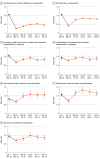A Population-Based Analysis of Diabetes-Related Care Measures, Foot Complications, and Amputation During the COVID-19 Pandemic in Ontario, Canada
- PMID: 34985514
- PMCID: PMC8733837
- DOI: 10.1001/jamanetworkopen.2021.42354
A Population-Based Analysis of Diabetes-Related Care Measures, Foot Complications, and Amputation During the COVID-19 Pandemic in Ontario, Canada
Abstract
Importance: Deferred diabetic foot screening and delays in timely care of acute foot complications during the COVID-19 pandemic may have contributed to an increase in limb loss.
Objective: To evaluate the association of the COVID-19 pandemic with diabetes-related care measures, foot complications, and amputation.
Design, setting, and participants: This population-based cohort study included all adult residents of Ontario, Canada, with diabetes and compared the rates of selected outcomes from January 1, 2020, to February 23, 2021, vs January 1, 2019, to February 23, 2020.
Main outcomes and measures: Comprehensive in-person diabetes care assessment, including foot examination; hemoglobin A1c (HbA1c) measurement; emergency department visit or hospitalization for diabetic foot ulceration, osteomyelitis, or gangrene; lower extremity open or endovascular revascularization; minor (toe or partial-foot) amputation; and major (above-ankle) leg amputation. Rates and rate ratios (RRs) comparing 2020-2021 vs 2019-2020 for each measure were calculated for 10-week periods, anchored relative to onset of the pandemic on March 11, 2020 (11th week of 2020).
Results: On March 11, 2020, the study included 1 488 605 adults with diabetes (median [IQR] age, 65 [55-74] years; 776 665 [52.2%] men), and on March 11, 2019, the study included 1 441 029 adults with diabetes (median [IQR] age, 65 [55-74] years; 751 459 [52.1%] men). After the onset of the pandemic, rates of major amputation in 2020-2021 decreased compared with 2019-2020 levels. The RR for the prepandemic period from January 1 to March 10 was 1.05 (95% CI, 0.88-1.25), with RRs in the pandemic periods ranging from 0.86 (95% CI, 0.72-1.03) in May 20 to July 28 to 0.95 (95% CI, 0.80-1.13) in October 7 to December 15. There were no consistent differences in demographic characteristics or comorbidities of patients undergoing amputation in the 2020-2021 vs 2019-2020 periods. Rates of comprehensive in-person diabetes care assessment and HbA1c measurement declined sharply and remained below 2019-2020 levels (eg, in-person assessment, March 11 to May 19: RR, 0.28; 95% CI, 0.28-0.28). The rates of emergency department visits (eg, March 11 to May 19: RR, 0.67; 95% CI, 0.61-0.75), hospitalization (eg, March 11 to May 19: RR, 0.77; 95% CI, 0.68-0.87), open revascularization (eg, March 11 to May 19: RR, 0.66; 95% CI, 0.56-0.79), endovascular revascularization (March 11 to May 19: RR, 0.70; 95% CI, 0.61-0.81), and minor amputation (March 11 to May 19: RR, 0.70; 95% CI, 0.60-0.83) initially dropped but recovered to 2019-2020 levels over the study period.
Conclusions and relevance: In this population-based cohort study, disruptions in care related to the COVID-19 pandemic were not associated with excess leg amputations among people living with diabetes. As the pandemic ends, improved prevention and treatment of diabetic foot complications will be necessary to maintain these positive results.
Conflict of interest statement
Figures


Similar articles
-
Comparison of Self-harm or Overdose Among Adolescents and Young Adults Before vs During the COVID-19 Pandemic in Ontario.JAMA Netw Open. 2022 Jan 4;5(1):e2143144. doi: 10.1001/jamanetworkopen.2021.43144. JAMA Netw Open. 2022. PMID: 35019981 Free PMC article.
-
Lower Extremity Amputations Among Patients with Diabetes Mellitus: A Five-Year Analysis in a Clinical Hospital in Bucharest, Romania.Medicina (Kaunas). 2024 Dec 4;60(12):2001. doi: 10.3390/medicina60122001. Medicina (Kaunas). 2024. PMID: 39768881 Free PMC article.
-
Lower Extremity Amputation Rates in People With Diabetes Mellitus: A Retrospective Population Based Cohort Study in Zwolle Region, The Netherlands.Eur J Vasc Endovasc Surg. 2023 Aug;66(2):229-236. doi: 10.1016/j.ejvs.2023.05.030. Epub 2023 May 21. Eur J Vasc Endovasc Surg. 2023. PMID: 37220802
-
A review of disparities in peripheral artery disease and diabetes-related amputations during the COVID-19 pandemic.Semin Vasc Surg. 2023 Mar;36(1):90-99. doi: 10.1053/j.semvascsurg.2022.12.002. Epub 2022 Dec 23. Semin Vasc Surg. 2023. PMID: 36958904 Free PMC article. Review.
-
Global trends in the incidence of hospital admissions for diabetes-related foot disease and amputations: a review of national rates in the 21st century.Diabetologia. 2023 Feb;66(2):267-287. doi: 10.1007/s00125-022-05845-9. Epub 2022 Dec 13. Diabetologia. 2023. PMID: 36512083 Review.
Cited by
-
Impact of COVID-19 Crisis in the Management of Diabetic Foot Patients in King Abdulaziz University Hospital, Jeddah, Saudi Arabia.Cureus. 2023 Mar 24;15(3):e36613. doi: 10.7759/cureus.36613. eCollection 2023 Mar. Cureus. 2023. PMID: 37102036 Free PMC article.
-
Effects of the COVID-19 Pandemic on Primary Health Care for Chronic Conditions in Canada: Protocol for a Retrospective Pre-Post Study Using National Practice-Based Research Network Data.JMIR Res Protoc. 2023 Jul 21;12:e49131. doi: 10.2196/49131. JMIR Res Protoc. 2023. PMID: 37477967 Free PMC article.
-
Effects of COVID-19 on diabetes care among dutch diabetes outpatients.Diabetol Metab Syndr. 2023 Oct 10;15(1):193. doi: 10.1186/s13098-023-01169-9. Diabetol Metab Syndr. 2023. PMID: 37817214 Free PMC article.
-
Impact of COVID-19 on diabetes care: mixed methods study in an Indigenous area of Guatemala.BMJ Open. 2024 Jan 2;14(1):e079130. doi: 10.1136/bmjopen-2023-079130. BMJ Open. 2024. PMID: 38167279 Free PMC article.
-
Efficacy of telemedicine applications in patients with diabetic foot ulcers: A focus on mortality and major amputation rates.Int Wound J. 2023 Dec;20(10):3955-3962. doi: 10.1111/iwj.14283. Epub 2023 Jun 20. Int Wound J. 2023. PMID: 37340728 Free PMC article.
References
-
- Botros M, Kuhnke J, Embil J, et al. . Best practice recommendations for the prevention and management of diabetic foot ulcers. Accessed June 7, 2021. https://www.woundscanada.ca/docman/public/health-care-professional/bpr-w...
-
- International Working Group on the Diabetic Foot . IWGDF guidelines on the prevention and management of diabetic foot disease. Accessed December 1, 2021. https://iwgdfguidelines.org/
Publication types
MeSH terms
Substances
LinkOut - more resources
Full Text Sources
Medical
Research Materials

